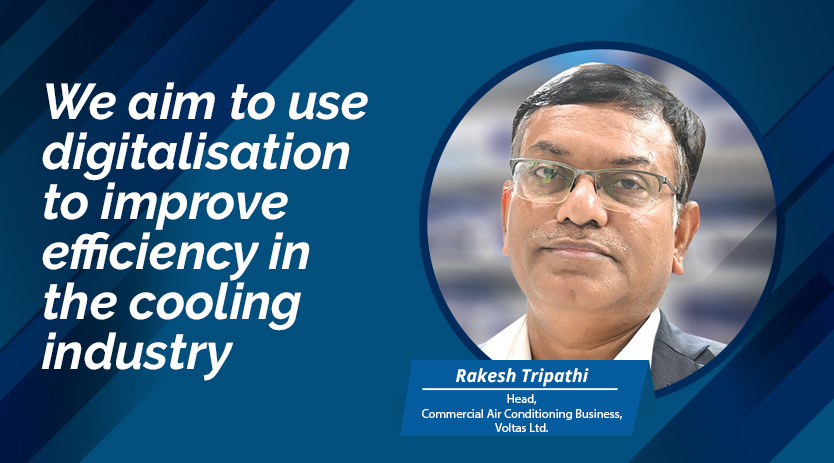In this interview, Rakesh Tripathi, Head of Commercial AC, Voltas, discusses the company’s expansion plans and strategies for thriving in an established market through sustainable production. He also delves into exploring options for improving indoor air quality.
What types of HVAC products and solutions does your company offer, and how do you ensure customer satisfaction throughout the product lifecycle?
We provide various HVAC products and solutions, catering to various needs. Our offerings include room air-conditioning, cassette and tower ACs for smaller spaces; VRF, ducted and package ACs for the larger commercial and retail spaces. Our specialized chillers are for the larger infra projects such as airports, malls and others. Furthermore, we don’t just stop at sales but also provide maintenance and retrofit services throughout the customer’s lifecycle. We take pride in offering comprehensive HVAC solutions to meet our customer’s requirements.
Indoor air quality is a challenging conversation today across major cities in India. What is the most efficient way to address the issue?
Voltas provides diverse alternatives to improve indoor air quality, and the COVID-19 pandemic has brought greater recognition to its solutions. These options are now commonly referenced by consultants and clients when considering specifications. Indoor air quality is a vital aspect of our remedial services, as it can significantly enhance people’s quality of life.
How is India’s cooling action plan energising the adoption of HVAC solutions in India?
ICAP is a remarkable initiative that addresses the industry’s and its customers’ requirements. It merges the interests of consumers and businesses to provide more efficient and sustainable goods and services. Our primary focus is on decarbonisation, which ICAP aims to improve upon.
What are the innovations in cooling technologies for large and public spaces?
Manufacturers continuously strive to improve efficiency for larger public spaces, resulting in reduced energy consumption for cooling. This is an ongoing process, and the industry is gradually progressing towards higher efficiency. At the same time, the world is rapidly adopting new technologies and moving towards digitalisation.
Digitalization has the potential to be a crucial tool in this industry. For instance, our chillers have a digital lab as part of our solution. While creating more efficient chillers is essential, how they are utilised is equally important. Our IoT solution helps customers operate their larger applications more effectively We also developed an IoT application for medium-sized applications, such as retail settings, where frequent opening and closing of doors leads to significant energy loss. Our solutions are designed to enhance the efficiency of such areas.
What opportunities does the current scenario of rising temperatures and the government’s ambition for a $5 trillion economy present for the HVAC industry?
Despite it only the start of the year, many areas of the nation are experiencing some of the highest temperatures in recent memory. Records for rising temperatures are consistently being broken. Along with our Prime Minister’s vision for a $5 trillion economy and its rapid expansion, we now have more disposable income, allowing us to prioritise our comfort. Air conditioning is now considered a necessity rather than a luxury.
This scenario creates an opportunity for us to support economic growth and the expansion of the HVAC market at a rate higher than that of industrialised nations. We aim to achieve a low double-digit CAGR over the next few years, providing all players with a fantastic opportunity to advance in their respective trades. For innovative firms like us that strive to add more value to our clients, we can expect to grow even more rapidly than the market rate.

What are the main focus areas for your technology and solutions strategy, and how do you plan to contribute to the industry’s growth?
We have two primary areas of focus regarding technology and solutions. Firstly, we strive to design more efficient and reliable systems by working on traditional equipment and engineering while reducing redundancies. Secondly, we aim to drive industry growth by developing new applications. Digitalisation is a crucial aspect of our strategy, and we have already introduced digital solutions for large spaces like chillers. Recently, we launched a digital solution for retail spaces. We aim to contribute substantially to the industry’s growth by combining these efforts.
What are the primary methods for reducing energy consumption and costs, and what specific measures are being taken to achieve these objectives?
Two primary ways to reduce energy consumption and costs are to improve equipment efficiency and the system’s efficiency. Both of these methods require a significant amount of engineering expertise. Another approach is to decrease the number of materials used in equipment manufacturing through value engineering. Additionally, optimising equipment operation through artificial intelligence and digital tools can enhance system efficiency. To achieve this goal, we require digital tools, an area of focus for digitalisation.
Our strategy for reducing energy consumption and costs involves two main approaches. Firstly, we aim to improve equipment and system efficiency, which demands significant engineering knowledge and expertise. Secondly, we seek to minimise the material utilised in equipment manufacturing by using value engineering. Finally, we are exploring ways to enhance equipment operation using artificial intelligence and digital tools. This can lead to a rise in overall system efficiency. We are concentrating on digitalisation to achieve this objective, where we are currently investing our efforts.
What measures are being taken to improve efficiency and enhance the customer experience?
The industry is growing rapidly, with a double-digit expansion rate expected. The sector is predicted to experience a strong compounded annual growth rate (CAGR) due to climate change and increased income. Our goal is to expand even faster than the industry. We are concentrating on several key areas to accomplish this, as much internal work is needed. Improving efficiency, not just through engineering and innovation, is crucial. Additionally, enhancing the customer experience is a top priority.
Cookie Consent
We use cookies to personalize your experience. By continuing to visit this website you agree to our Terms & Conditions, Privacy Policy and Cookie Policy.















